engine VOLVO XC90 TWIN ENGINE HYBRID 2017 Workshop Manual
[x] Cancel search | Manufacturer: VOLVO, Model Year: 2017, Model line: XC90 TWIN ENGINE HYBRID, Model: VOLVO XC90 TWIN ENGINE HYBRID 2017Pages: 584, PDF Size: 14.2 MB
Page 233 of 584

LOADING AND STORAGE
}}
231
trained and qualified Volvo service techni-cian.
Failure to follow the points above could resultin electrical shock and/or serious injury.
Status indication
An LED (Light Emitting Diode) on the socketindicates its status:
Status indicator lightSocket statusAction
Steady green lightThe socket is providing current to a connected device.None.
Flashing orange lightThe socket's voltage converter is too hot (the connected device draws too muchcurrent, etc. or the temperature in the passenger compartment is very high).Unplug the device, let the converter cool downand plug in the device again.
The connected device draws too much current (constantly or currently) or is notfunctioning properly.None. The device should not be plugged into thesocket.
Indicator light offThe socket has not detected a plugged in device.Be sure the device is correctly plugged into thesocket.
The socket is not active.Put the vehicle's ignition in at least mode I.
The socket has been active but has been deactivated.Start the engine and/or charge the start battery.
If a problem persists, have the socket checked bya trained and qualified Volvo service technician.
Page 234 of 584
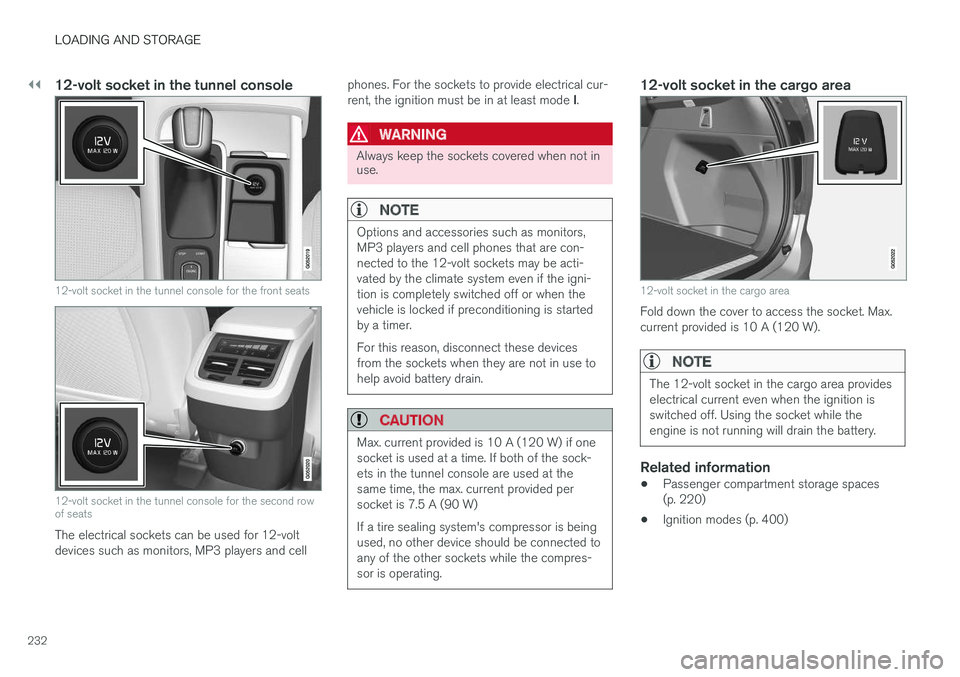
||
LOADING AND STORAGE
232
12-volt socket in the tunnel console
12-volt socket in the tunnel console for the front seats
12-volt socket in the tunnel console for the second rowof seats
The electrical sockets can be used for 12-voltdevices such as monitors, MP3 players and cell
phones. For the sockets to provide electrical cur-rent, the ignition must be in at least mode I.
WARNING
Always keep the sockets covered when not inuse.
NOTE
Options and accessories such as monitors,MP3 players and cell phones that are con-nected to the 12-volt sockets may be acti-vated by the climate system even if the igni-tion is completely switched off or when thevehicle is locked if preconditioning is startedby a timer.
For this reason, disconnect these devicesfrom the sockets when they are not in use tohelp avoid battery drain.
CAUTION
Max. current provided is 10 A (120 W) if onesocket is used at a time. If both of the sock-ets in the tunnel console are used at thesame time, the max. current provided persocket is 7.5 A (90 W)
If a tire sealing system's compressor is beingused, no other device should be connected toany of the other sockets while the compres-sor is operating.
12-volt socket in the cargo area
12-volt socket in the cargo area
Fold down the cover to access the socket. Max.current provided is 10 A (120 W).
NOTE
The 12-volt socket in the cargo area provideselectrical current even when the ignition isswitched off. Using the socket while theengine is not running will drain the battery.
Related information
•Passenger compartment storage spaces(p. 220)
•Ignition modes (p. 400)
Page 236 of 584
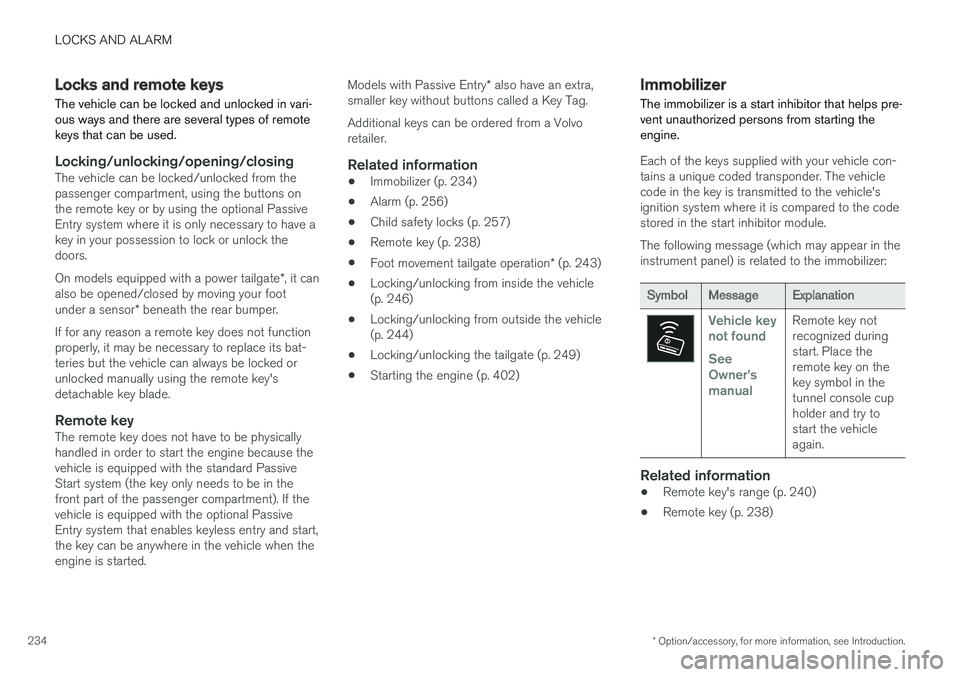
LOCKS AND ALARM
* Option/accessory, for more information, see Introduction.234
Locks and remote keys
The vehicle can be locked and unlocked in vari-ous ways and there are several types of remotekeys that can be used.
Locking/unlocking/opening/closing
The vehicle can be locked/unlocked from thepassenger compartment, using the buttons onthe remote key or by using the optional PassiveEntry system where it is only necessary to have akey in your possession to lock or unlock thedoors.
On models equipped with a power tailgate*, it canalso be opened/closed by moving your footunder a sensor* beneath the rear bumper.
If for any reason a remote key does not functionproperly, it may be necessary to replace its bat-teries but the vehicle can always be locked orunlocked manually using the remote key'sdetachable key blade.
Remote key
The remote key does not have to be physicallyhandled in order to start the engine because thevehicle is equipped with the standard PassiveStart system (the key only needs to be in thefront part of the passenger compartment). If thevehicle is equipped with the optional PassiveEntry system that enables keyless entry and start,the key can be anywhere in the vehicle when theengine is started.
Models with Passive Entry* also have an extra,smaller key without buttons called a Key Tag.
Additional keys can be ordered from a Volvoretailer.
Related information
•Immobilizer (p. 234)
•Alarm (p. 256)
•Child safety locks (p. 257)
•Remote key (p. 238)
•Foot movement tailgate operation* (p. 243)
•Locking/unlocking from inside the vehicle(p. 246)
•Locking/unlocking from outside the vehicle(p. 244)
•Locking/unlocking the tailgate (p. 249)
•Starting the engine (p. 402)
Immobilizer
The immobilizer is a start inhibitor that helps pre-vent unauthorized persons from starting theengine.
Each of the keys supplied with your vehicle con-tains a unique coded transponder. The vehiclecode in the key is transmitted to the vehicle'signition system where it is compared to the codestored in the start inhibitor module.
The following message (which may appear in theinstrument panel) is related to the immobilizer:
SymbolMessageExplanation
Vehicle keynot found
SeeOwner'smanual
Remote key notrecognized duringstart. Place theremote key on thekey symbol in thetunnel console cupholder and try tostart the vehicleagain.
Related information
•Remote key's range (p. 240)
•Remote key (p. 238)
Page 240 of 584
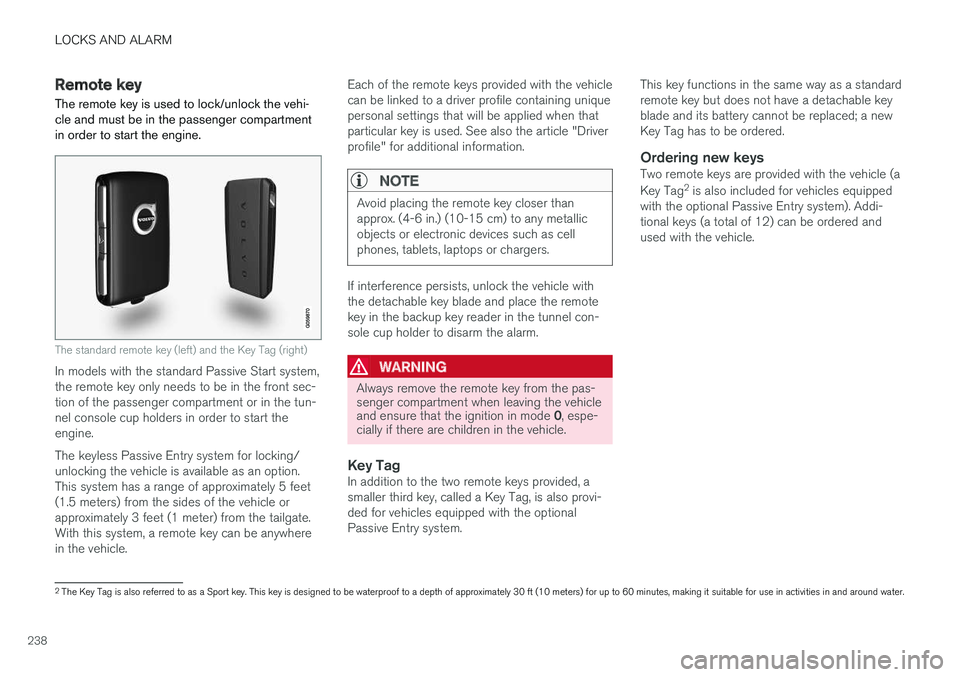
LOCKS AND ALARM
238
Remote key
The remote key is used to lock/unlock the vehi-cle and must be in the passenger compartmentin order to start the engine.
The standard remote key (left) and the Key Tag (right)
In models with the standard Passive Start system,the remote key only needs to be in the front sec-tion of the passenger compartment or in the tun-nel console cup holders in order to start theengine.
The keyless Passive Entry system for locking/unlocking the vehicle is available as an option.This system has a range of approximately 5 feet(1.5 meters) from the sides of the vehicle orapproximately 3 feet (1 meter) from the tailgate.With this system, a remote key can be anywherein the vehicle.
Each of the remote keys provided with the vehiclecan be linked to a driver profile containing uniquepersonal settings that will be applied when thatparticular key is used. See also the article "Driverprofile" for additional information.
NOTE
Avoid placing the remote key closer thanapprox. (4-6 in.) (10-15 cm) to any metallicobjects or electronic devices such as cellphones, tablets, laptops or chargers.
If interference persists, unlock the vehicle withthe detachable key blade and place the remotekey in the backup key reader in the tunnel con-sole cup holder to disarm the alarm.
WARNING
Always remove the remote key from the pas-senger compartment when leaving the vehicleand ensure that the ignition in mode 0, espe-cially if there are children in the vehicle.
Key Tag
In addition to the two remote keys provided, asmaller third key, called a Key Tag, is also provi-ded for vehicles equipped with the optionalPassive Entry system.
This key functions in the same way as a standardremote key but does not have a detachable keyblade and its battery cannot be replaced; a newKey Tag has to be ordered.
Ordering new keys
Two remote keys are provided with the vehicle (a
Key Tag2 is also included for vehicles equippedwith the optional Passive Entry system). Addi-tional keys (a total of 12) can be ordered andused with the vehicle.
2The Key Tag is also referred to as a Sport key. This key is designed to be waterproof to a depth of approximately 30 ft (10 meters) for up to 60 minutes, making it suitable for use in activities in and around water.
Page 242 of 584
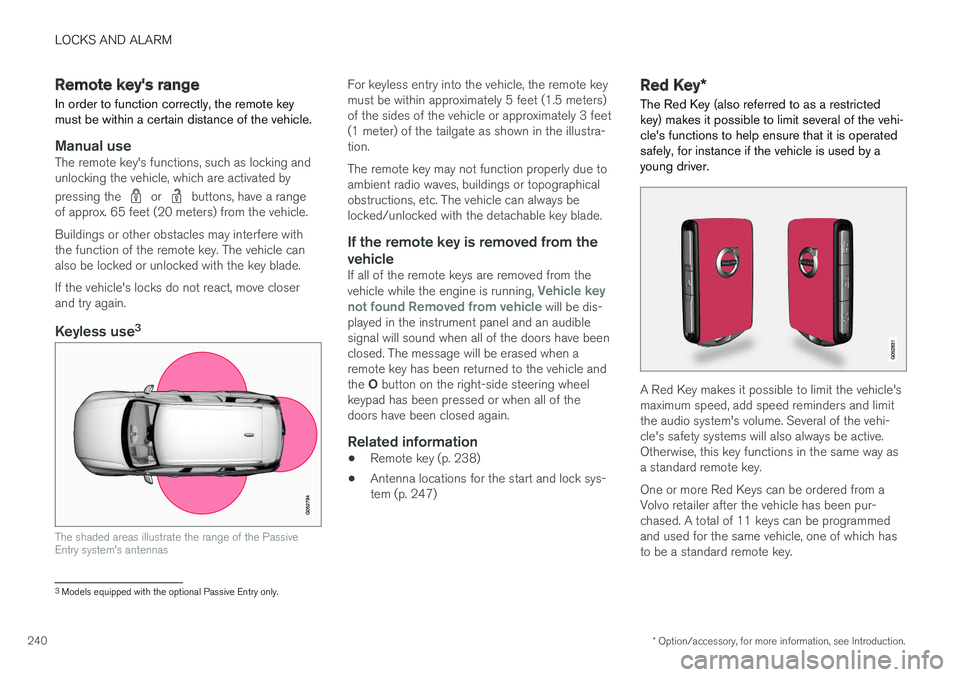
LOCKS AND ALARM
* Option/accessory, for more information, see Introduction.240
Remote key's range
In order to function correctly, the remote keymust be within a certain distance of the vehicle.
Manual use
The remote key's functions, such as locking andunlocking the vehicle, which are activated by
pressing the or buttons, have a rangeof approx. 65 feet (20 meters) from the vehicle.
Buildings or other obstacles may interfere withthe function of the remote key. The vehicle canalso be locked or unlocked with the key blade.
If the vehicle's locks do not react, move closerand try again.
Keyless use 3
The shaded areas illustrate the range of the PassiveEntry system's antennas
For keyless entry into the vehicle, the remote keymust be within approximately 5 feet (1.5 meters)of the sides of the vehicle or approximately 3 feet(1 meter) of the tailgate as shown in the illustra-tion.
The remote key may not function properly due toambient radio waves, buildings or topographicalobstructions, etc. The vehicle can always belocked/unlocked with the detachable key blade.
If the remote key is removed from the
vehicle
If all of the remote keys are removed from thevehicle while the engine is running, Vehicle keynot found Removed from vehicle will be dis-played in the instrument panel and an audiblesignal will sound when all of the doors have beenclosed. The message will be erased when aremote key has been returned to the vehicle andthe O button on the right-side steering wheelkeypad has been pressed or when all of thedoors have been closed again.
Related information
•Remote key (p. 238)
•Antenna locations for the start and lock sys-tem (p. 247)
Red Key*
The Red Key (also referred to as a restrictedkey) makes it possible to limit several of the vehi-cle's functions to help ensure that it is operatedsafely, for instance if the vehicle is used by ayoung driver.
A Red Key makes it possible to limit the vehicle'smaximum speed, add speed reminders and limitthe audio system's volume. Several of the vehi-cle's safety systems will also always be active.Otherwise, this key functions in the same way asa standard remote key.
One or more Red Keys can be ordered from aVolvo retailer after the vehicle has been pur-chased. A total of 11 keys can be programmedand used for the same vehicle, one of which hasto be a standard remote key.
3
Models equipped with the optional Passive Entry only.
Page 259 of 584

LOCKS AND ALARM
}}
* Option/accessory, for more information, see Introduction.257
the ignition has been put in mode I (turn thestart knob to START and release it): thealarm has been triggered
Related information
•Automatically arming/disarming the alarm(p. 255)
•Deactivating the alarm without a functioningremote key (p. 257)
Deactivating the alarm without afunctioning remote key
If the remote key is not functioning properly, thealarm can be turned off and the vehicle can bestarted as follows:
1. Unlock and open the driver's door with thedetachable key blade.
>This will trigger the alarm.
Location of the back-up key reader in the cup holder
2. Place the remote key on the back-up keyreader in the tunnel console's cup holder.
3.Turn the start knob to START and release it.
>The alarm will turn off.
Related information
•Alarm (p. 256)
•Detachable key blade (p. 242)
•Starting the engine (p. 402)
•Automatically arming/disarming the alarm(p. 255)
Child safety locks
Child safety locks help prevent children frominadvertently opening one of the rear doors frominside the vehicle.
Electronic * activation/deactivation
The electronic child safety locks can be acti-vated/deactivated as long as the ignition is notcompletely switched off and this can be done forup to two minutes after the engine has beenswitched off if no door has been opened.
To activate:
Child safety lock button on the driver door control panel
1. Switch on the ignition or start the engine.
Page 265 of 584
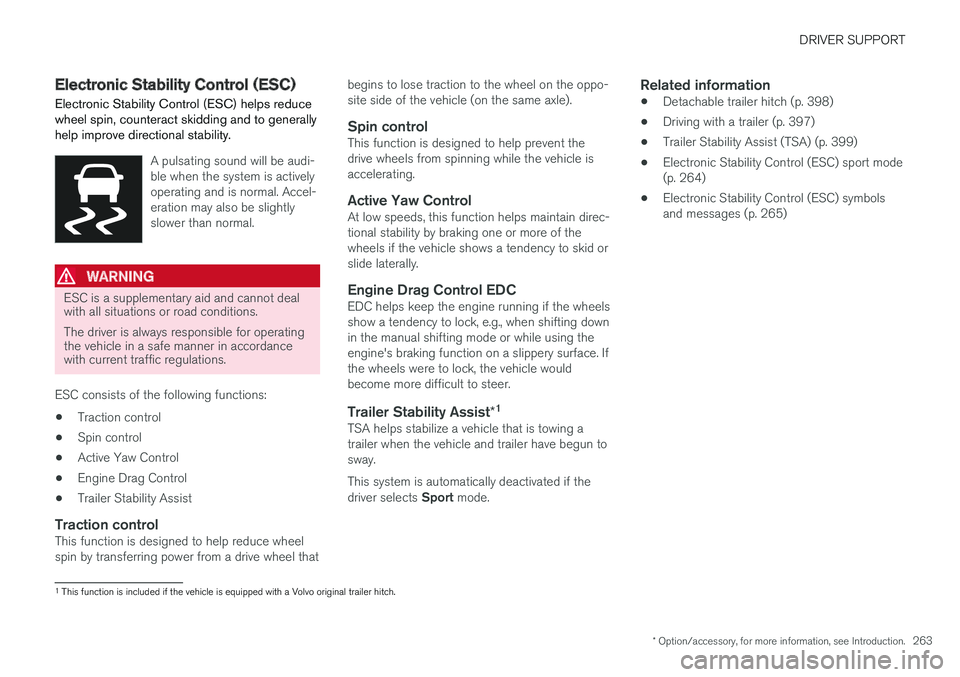
DRIVER SUPPORT
* Option/accessory, for more information, see Introduction.263
Electronic Stability Control (ESC)
Electronic Stability Control (ESC) helps reducewheel spin, counteract skidding and to generallyhelp improve directional stability.
A pulsating sound will be audi-ble when the system is activelyoperating and is normal. Accel-eration may also be slightlyslower than normal.
WARNING
ESC is a supplementary aid and cannot dealwith all situations or road conditions.
The driver is always responsible for operatingthe vehicle in a safe manner in accordancewith current traffic regulations.
ESC consists of the following functions:
•Traction control
•Spin control
•Active Yaw Control
•Engine Drag Control
•Trailer Stability Assist
Traction control
This function is designed to help reduce wheelspin by transferring power from a drive wheel that
begins to lose traction to the wheel on the oppo-site side of the vehicle (on the same axle).
Spin control
This function is designed to help prevent thedrive wheels from spinning while the vehicle isaccelerating.
Active Yaw Control
At low speeds, this function helps maintain direc-tional stability by braking one or more of thewheels if the vehicle shows a tendency to skid orslide laterally.
Engine Drag Control EDC
EDC helps keep the engine running if the wheelsshow a tendency to lock, e.g., when shifting downin the manual shifting mode or while using theengine's braking function on a slippery surface. Ifthe wheels were to lock, the vehicle wouldbecome more difficult to steer.
Trailer Stability Assist * 1
TSA helps stabilize a vehicle that is towing atrailer when the vehicle and trailer have begun tosway.
This system is automatically deactivated if thedriver selects Sport mode.
Related information
•Detachable trailer hitch (p. 398)
•Driving with a trailer (p. 397)
•Trailer Stability Assist (TSA) (p. 399)
•Electronic Stability Control (ESC) sport mode(p. 264)
•Electronic Stability Control (ESC) symbolsand messages (p. 265)
1
This function is included if the vehicle is equipped with a Volvo original trailer hitch.
Page 266 of 584
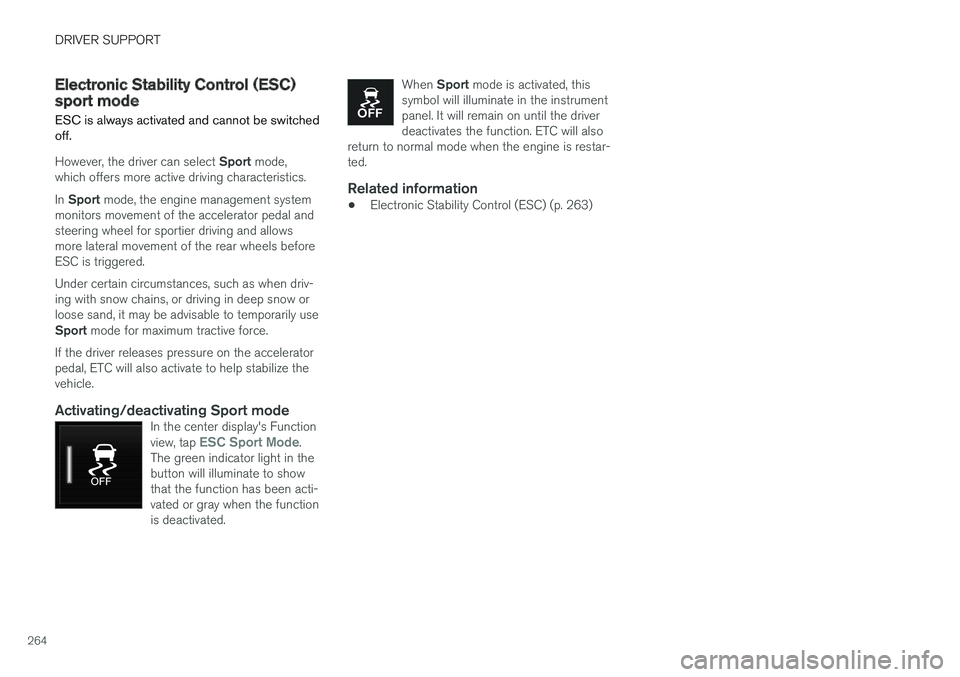
DRIVER SUPPORT
264
Electronic Stability Control (ESC)sport mode
ESC is always activated and cannot be switchedoff.
However, the driver can select Sport mode,which offers more active driving characteristics.
In Sport mode, the engine management systemmonitors movement of the accelerator pedal andsteering wheel for sportier driving and allowsmore lateral movement of the rear wheels beforeESC is triggered.
Under certain circumstances, such as when driv-ing with snow chains, or driving in deep snow orloose sand, it may be advisable to temporarily useSport mode for maximum tractive force.
If the driver releases pressure on the acceleratorpedal, ETC will also activate to help stabilize thevehicle.
Activating/deactivating Sport mode
In the center display's Functionview, tap ESC Sport Mode.The green indicator light in thebutton will illuminate to showthat the function has been acti-vated or gray when the functionis deactivated.
When Sport mode is activated, thissymbol will illuminate in the instrumentpanel. It will remain on until the driverdeactivates the function. ETC will alsoreturn to normal mode when the engine is restar-ted.
Related information
•Electronic Stability Control (ESC) (p. 263)
Page 267 of 584
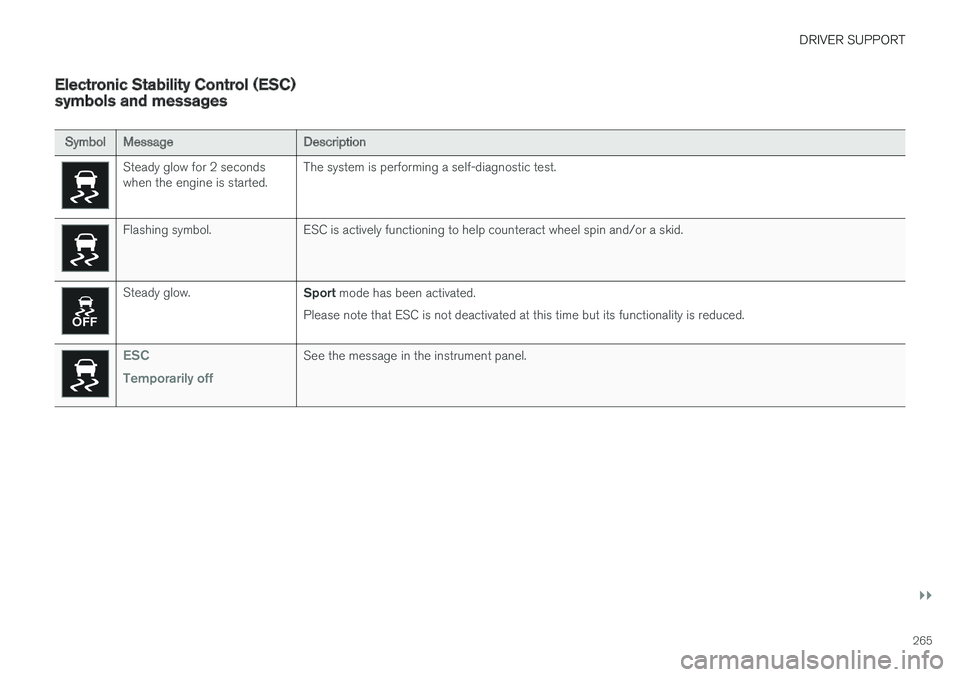
DRIVER SUPPORT
}}
265
Electronic Stability Control (ESC)symbols and messages
SymbolMessageDescription
Steady glow for 2 secondswhen the engine is started.The system is performing a self-diagnostic test.
Flashing symbol.ESC is actively functioning to help counteract wheel spin and/or a skid.
Steady glow.Sport mode has been activated.
Please note that ESC is not deactivated at this time but its functionality is reduced.
ESC
Temporarily off
See the message in the instrument panel.
Page 268 of 584

||
DRIVER SUPPORT
266
SymbolMessageDescription
ESC Temporarily offThe ESC system function has been temporarily reduced due to high brake disc temperature. The function reac-tivates automatically when the brakes have cooled.
ESC Service requiredThe ESC system is not functioning properly.
•Stop the vehicle in a safe place, turn off the engine and restart it.
•If the message is still displayed when the engine has restarted, drive to an authorized Volvo workshop tohave the system inspected.
WARNING
The stability system is intended to helpimprove driving safety. It supplements, but cannever replace, the driver's judgment andresponsibility when operating the vehicle.Speed and driving style should always beadapted to traffic and road conditions.
Related information
•Electronic Stability Control (ESC) (p. 263)